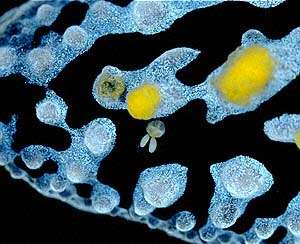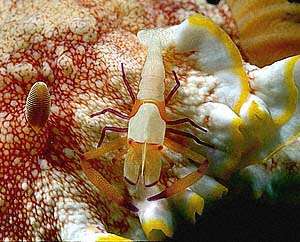

Symbiosis, commensalism, mutualism and parasitism
PHOTO
Upper: A small copepod crustacean (note paired egg sacs) on Phyllidia coelestis, Koumac, New Caledonia, Oct, 1993. Lower: The commensal shrimp Periclimenes imperator on Chromodoris tinctoria, Koumac, New Caledonia, Oct, 1993. Photos: Bill Rudman.
There are many examples in nature of two organisms living in close association with each other. The relationship can consist of two animals, two plants, a plant and an animal, or even a fungus and an algae (such as in lichens). Biologists have tried to give names to and define certain examples of 'living together' such as 'symbiosis' and 'mutualism' and 'parasitism' but it is often difficult to know where one type of association ends and another begins. It is probably better to think of these associations as part of a broad continuum ranging from free-living organisms that depend on others for food, to two organisms that will not survive unless they are always together such as the alga and fungus that combine to form each lichen 'species'.
Here are definitions of a few of the most common words used by biologists to classify such inter-relationships.
• Symbiosis: This comes from a Greek word simply meaning 'living together' and can be used to describe any association between two organisms.
• Mutualism: This can be used to describe an association in which both organisms apparently benefit
• Commensalism: In this association one organism [the commensal] benefits, and the other [the host] is apparently unaffected.
• Parasitism In this association one organism [the parasite] benefits, and the other [the host] is adversely affected [weakened, sickened, damaged etc]. This description would also fit the relationship between a carnivore and its live prey and a herbivore and the plant it feeds on, especially if they are very specialized in the food they eat. We normally define parasites as orgamisms which cannot survive without their host and have special modifications to their body or their life cycle for this association. In many ways though, the difference between a lion eating a gazelle and a flea feeding on a dog, is a matter of relative size.
Many sea slugs have evolved close relationships with other organisms. The simplest associations are the many nudibranchs which are permanently found on, or close by, the organisms they feed on. These in include dorids and their sponges, aeolids on their cnidarians, polycerids on their bryozoans. Here are a few particular examples:
• Commensal crustaceans: The photos at the top of this page show two crustaceans, a copepod and a shrimp, which live in close association with various nudibranchs. They illustarte the many crustaceans which are often found to have close relationships to various sea slugs. In most cases we know nothing about the relationships, but they are generally referred to as 'commensals'. The copepods are small crustacea often found living on dorid nudibranchs. They are easily recognised because their two large egg sacs look like a pair of large 'tails'. Another more spectacular example is the shrimp, Periclimenes imperator, which is always found living on large dorid nudibranchs such as the Spanish Dancer, Hexabranchus, or on chromodorids such as Chromodoris tinctoria.
• Coral feeding nudibranchs: These nudibranchs live their lives on or under the coral colonies they feed on.
• Solar Powered Sea Slugs: Another quite different group of relationships have been discovered with sea slugs which involves plants and plant organelles. One group, the herbivorous sacoglossan sea slugs keep chloroplasts and other plant plastids alive from the plants they eat, and use the sugars they produce from photosynthesis for theis own nutrition. Another group of carnivorous nudibranchs also show various degrees of ability to harness solar power by keeping whole single-celled plants (zooxanthellae) alive in their tissues for the same purpose.
• Gymnodoris nigricolor: Have a look at the page on Gymnodoris nigricolor, a nudibranch which lives with fishes of the Goby family, clinging on to, and apparently eating their fins.
Rudman, W.B., 2004 (July 24) Symbiosis, commensalism, mutualism and parasitism. [In] Sea Slug Forum. Australian Museum, Sydney. Available from http://www.seaslugforum.net/factsheet/symbio
Related messages
-
Re: Another goby on nudibranch
From: Andy Eastwood, February 11, 2009 -
Amphipod crustacean mimic (Southern California)
From: Matt Segal, February 4, 2006 -
Ceratosoma with Periclimenes imperator
From: Corby James, September 17, 2005 -
Commensalism in Californian nudibranchs
From: James Lyle & Leslie Harris, July 30, 2005 -
Amphipod commensal on Tritonia festiva
From: James Lyle & Leslie Harris, July 30, 2005 -
Another commensal scaleworm
From: James Lyle & Leslie Harris, July 30, 2005 -
Re: Another goby on nudibranch
From: Bill Rudman, July 11, 2005 -
Another goby on nudibranch
From: Jerry Allen, July 5, 2005 -
Commensal fish on Ceratosoma trilobatum
From: John Weinberg, June 27, 2005 -
Chromodoris coi with copepod
From: Fredy Brauchli, March 22, 2004 -
Mystery mark on Risbecia pulchella
From: Stephanie Maleady, January 25, 2004 -
It's a puzzle
From: Mary Jane Adams, May 10, 2002 -
Symbiotic stress
From: Ali, April 10, 2002 -
Ceratosoma trilobatum with commensal shrimp
From: Mary Jane Adams, September 21, 2001 -
Mutualism and symbiosis
From: Lindsay Jennings, January 24, 2001 -
Examples of Symbiosis
From: Sutha, August 23, 2000 -
Commensalistic Symbiosis
From: Josh Williamsen, March 24, 2000 -
Examples of endoecism
From: Sonia, December 9, 1999 -
Nudibranch with commensal shrimp
From: Erik Schloegl, November 14, 1999 -
Slugs and Microbes
From: Daniel Vega Mendoza, June 5, 1999 -
Information about commensalism
From: Kara Hailey, February 20, 1999 -
Commensalism
From: Kerry, January 18, 1999 -
Parasite and Mutualistic relationships
From: Tammy Pearson, November 21, 1998 -
"Commensalistic symbiosis"
From: Laura, October 30, 1998 -
symbiosis
From: unidentified enquirer, October 25, 1998 -
Symbiosis and commensalism
From: , March 28, 1998
